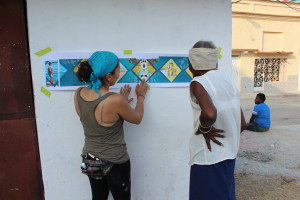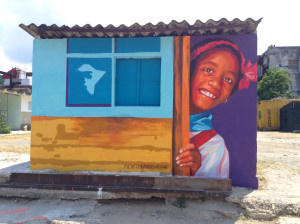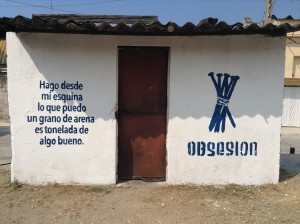You may remember Michelle Angela Ortiz, a mural artist based in Philadelphia, from Meridian International Center’s Cuba Forum on June 9th. She recently returned from Cuba as part of Meridian’s Community Engagement through the Mural Arts program, a joint initiative with the State Department’s Bureau of Educational and Cultural Affairs. There, she worked with the local community in Regla to create stunning works of public art. We spoke with her about her experience, methodology, and the power of art to transform communities.
GG: Michelle, you’ve now participated in Meridian’s Mural Arts Exchanges to Honduras (2015) and Cuba (2016). These two countries have very distinct cultures, histories, political systems, and relationships with United States, and are facing different challenges both internally and externally. How did you find that the realities facing the communities in Cuba and Honduras were similar or different? How did your experiences with these communities compare?
MAO: As you said, Honduras and Cuba both have very different political systems. The advances of free education and healthcare in Cuba is evident in that 98% of the population is completely literate. From my conversations with Cubans in my last residency, Cuba has low tolerance for drug trafficking and gun violence. This is in comparison to Honduras, where the violence plaguing communities has resulted in the largest amount of unaccompanied youth crossing borders to the United States. During my time in Honduras in March 2015, there were several student protests fighting against the lack of teaching materials and resources in schools, and the proposed extended classroom hours to 7pm, a dangerous hour that leaves school children vulnerable to becoming victims of violence as they try to return home. A young 13 year old girl and two boys were murdered for protesting and demanding the changes to the school infrastructure.
My approach is always to enter into a community, become educated in their history, respect their struggles, and create a space for them to share their realities, both positive and negative, through the creative process. I am clear about my intentions as an artist, and as a woman of color, child of immigrants, and activist, my perspective is different and I can be honest about the struggles that we have with racism, classism, and with the recent events in Orlando–gun violence in our country.
“Needless to say, when we see other countries and their issues, we must also recognize the issues and change needed in our own home country. The communities I work with abroad find that we are all trying to find a better way to live. And most importantly, to fight for the changes we want to see in our communities.“
What makes our projects different is that my role as an artist is not to teach the community to paint my vision, rather it is to create art work WITH the community, from the inception of the design to the final stroke of paint on the wall. I am an American artist (even though I consider myself very Latina) visiting to exchange ideas and skills with Cuban artists and the community. I understand that I have to push aside the stereotypes and assumptions imposed by the media of both countries to truly focus on the work that I am doing with the community in Havana. For these reasons, I am focused on creating a genuine experience where the participants and local artists can share their perspective through the creative lens. I believe that it is powerful to present images of the community and their messages especially in spaces that they are not always represented in.

GG: I understand you’ve had previous experience in Cuba, and had contacts in the art community prior to your most recent trip with Meridian. What is the process for finding community members to work on the project? Can you elaborate on the role of Obsesión in the most recent project?
MAO: My first visit to Cuba was in 2014. I participated in the International Festival of Poetry with my multi-disciplinary arts collective Las Gallas. During my time there, our collective offered a day long workshop in Regla with Afro-Cuban spoken word and visual artists from Havana. It was this initial trip that helped me connect directly with Magia Lopez from the Hip Hop group Obsesión. We spoke of the idea of returning to do a mural since there was an interest to do work specifically in Regla. When the call for artists from Meridian appeared, it was a great opportunity to make this idea into a reality. Obsesión (Magia Lopez and Alexey Rodriguez) are pioneers in Cuban Hip Hop; they are deeply committed to the cultural richness of the communities in Central Havana and Regla. They have worked for over 20 years by offering cultural events, organizing symposiums, and inviting artists that contribute to the cultural scene in Havana. Magia works directly with the Ministry of Culture and was the first director of the Agencia Cuba de Rap in Havana. Their experience and commitment is reflected in the trust of the neighbors and residents that helped pave the way to create the mural within the community space in Regla.
GG: You’ve talked about this your engagement with the community as central to your methodology. Can you expand on how the specific site in Cuba influenced the mural images? What can you tell us about the symbolism apparent in the final works?
MAO: In April I started working on our other walls with community members in Regla. Magia Lopez from Obsesión has organized cultural events in Regla for 20 years; the mural site is located where Obsesión organizes weekly hip hop and spoken word peñas. The mural site was recently visited by a delegation sent by Michelle Obama which included artists Smokey Robinson, Alfre Woodward, and Usher.
Regla is a deeply spiritual place and that is reflected by the people and the colorful altars in their homes. It is also a municipality with little resources, where they continue to struggle to have constant access to water and have homes that are deteriorating. Even through these struggles, Regla is a place filled with light and life within the people that call this place their home. We repaired the exterior walls and painted a mural that reflects “la vida coitidiana” of Regla.

Over 30 volunteers of all ages helped paint images of a young boy fishing, the lancha (boat) the main means of transportation, the ocean, and of course the Virgen de Regla in the center. As the only black Virgen in Cuba, the Virgen de Regla is directly associated with the African Orisha Yemaya, the mother of the earth that offers protection to her children. This duality is present in the faith of the people of Regla and in the image of the painted hand lighting a candle symbolizes this faith, a wish, and the power to create light when we encounter darkness.
The mural also includes an image of a young Afro-Cuban girl, Carla, representing the many children in the streets playing hide and seek. The images of Che and Fidel are very present in the murals of Havana. Painting the image of Carla is in itself a revolutionary act; my my intention was to honor the Afro-Cuban community and depict that Cuba thrives within its people.
GG: What classes, workshops, dialogues, did you find the most impactful?
MAO: Most people find that the completed mural has the most impact. Visually it does, but the workshops and conversations leading the completion of the mural is so important. I think the beauty of doing work in communities and in public spaces is the direct connection that I have with the people. As we painted, we had mothers, children, teenagers, elders, self-taught painters, community historians, come and talk about the work we were doing and offer their perspectives on the images that we were painting.
“Any time that I can bring people of all different walks of life and give them a moment to acknowledge and see the beauty of their collective voice through the arts, that is the biggest impact.”
GG: One of the goals of the program is “to advance US policy by addressing local community issues.” What’s your interpretation of how that goal was addressed?
I started developing this project in December 2015. My team of local artist, project coordinator, and I ran into many obstacles in painting a wall in Central Havana. That process was a learning moment and a look into the issues of bureaucracy that exists in Cuba. Through this process, I have learned about the system that the local artists must navigate to push forward community art projects like ours. What helped me through that process was the patience, determination, and commitment of the artists and the community.
“The struggles, creative process, and completion of a mural in Regla helped unite us; that unity surpasses the political history of both of our countries.”
GG: What do you hope to bring back to the US about your experience in Cuba, and how will you use this experience moving forward in your work?
MAO: I have learned to be more patient, to listen more, to be open when plans change and shift, and to believe that it is worth persisting when you know that meeting the goal will have a large impact on the community. I feel that more cultural exchanges are necessary as long as they benefit the community and support the continued work that local artists are doing in Cuba.
Overall, The words of Obsesión reflect best the impact that we want the mural to have,
“Hago desde mi esquina lo que puedo
Un grano de arena es tonelada
De algo bueno”
“From my corner I do what I can,
a grain of sand is a ton
if it is for something good”
Watch these short videos of Michelle’s work in Cuba and Honduras.
See more of Michelle’s art:
INSTAGRAM: @michelleangelaortiz


















